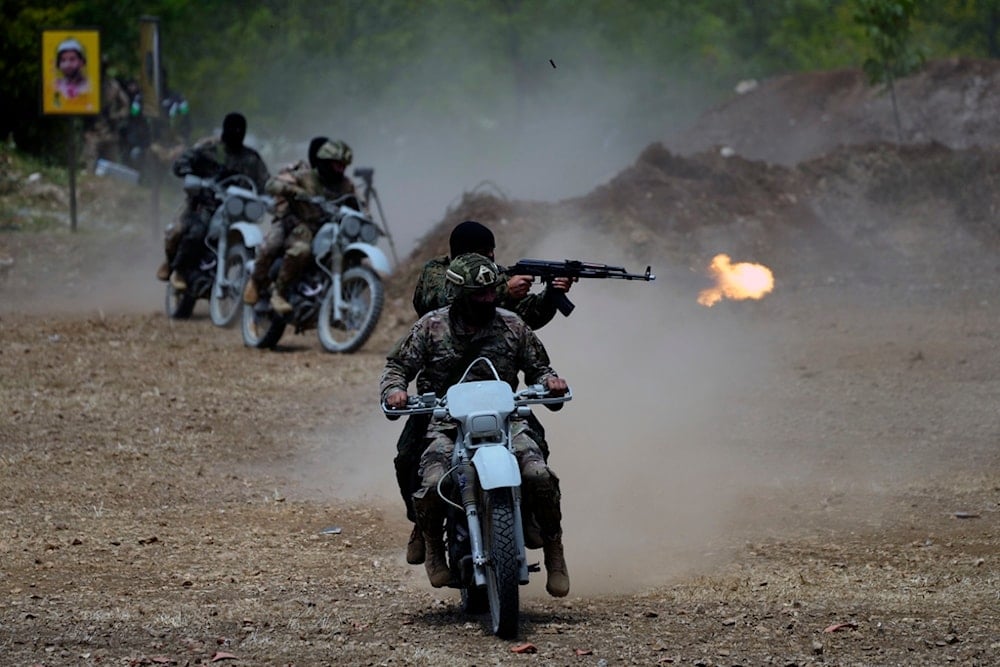War with Hezbollah could be 'Israel's' historic challenge: FP
An analysis published in Foreign Policy details the possible war scenario between "Israel" and Hezbollah in Lebanon, as a consequence of the occupation's recent aggression.
-

Fighters from the Lebanese Resistance group Hezbollah carry out a training exercise in Aaramta village in the Jezzine District, southern Lebanon, Sunday, May 21, 2023. (AP)
The Israeli assassination of Hamas chief Ismail Haniyeh in a targeted attack on his place of residence in Iran, paired with the assassination of Hezbollah's senior military commander Fouad Shokor in Beirut's Southern Suburb in Lebanon, might have braced both the occupation and Lebanon for escalations that could lead to a full-blown regional war.
Daniel Byman and Seth Jones both analyzed the probable regional war scenario in an op-ed published by Foreign Policy, beginning with the tit-for-tat engagement between "Israel" and Hezbollah in the Lebanese South, focusing on the major challenges the occupation would encounter against the Islamic Resistance in Lebanon, and explaining how it could expand across the region to reach the US and Iran.
Hezbollah's terrifying advantage
If the war deepens, Hezbollah will introduce its vast weapon arsenal which includes both long and short-range missiles and rockets that are more than capable of devastating "Israel", regardless of how much it prepares for war. These include several variations of the lethal Fateh and Zelzal guided and unguided missiles.
While "Israel" also possesses a large arsenal of weapons that the authors claim could deter Hezbollah's frontlines, the war could rapidly transform into smaller units engaging in [guerrilla] warfare. Hezbollah has skilled fighters and maneuvers that allow its forces to engage in combat and force its opponent to withdraw, as previously seen in 2000 during the liberation of the South, and in 2006 during the July War.
The Islamic Resistance's precedents in war in Lebanon, and operations in Syria, alongside Iran's Quds Force and Russian Armed Forces, have given it a major advantage over "Israel". Its fighters are highly spirited, possess a wide range of skills, can skillfully carry out complex operations, and fight their opponent regardless of brutality.
Hezbollah also possesses an arsenal of sophisticated weaponry, including anti-tank missiles and explosive devices, some of which were used in the 2006 attack on the Israeli Sa'ar 5 warship, and which have since been developed to include unfathomable capabilities.
The authors, moreover, mention the intricate and complex tunnel system "Israel" failed to be able to navigate during its previous wars in Lebanon, as well as in Gaza. Although "Israel" regularly trains and develops questionable skills in preparation for war against Hezbollah, the consequences could still shatter its hopes of emerging victorious.
On 'Israel's' frailty
The authors relay "Israel's" struggle against Hezbollah back to its current war on the Gaza Strip against the Palestinian Resistance movements, which it severely underestimated.
The Israeli occupation forces have served multiple rounds in Gaza for 10 months, and with the assassination of Haniyeh and continuous Israeli obstructions in negotiations, the fate of a ceasefire and the end of the war remain unknown.
Its arsenal is low on ammunition and lacks spare parts for its weapons, which could pose a challenge for suppliers in case of a potential large war with Lebanon.
"Israel" is also suffering on multiple economic fronts. The reliance on its reserves has strained its economy. Elsewhere, the damage inflicted by the Axis of Resistance has considerably punished the occupation economically, from shutting its businesses to driving investors away, as well as sending its economic strongholds [Eilat Port] into bankruptcy, scorching much of the revenues it could have gained had it ended the genocide in Gaza.
Internally, occupation soldiers are increasingly refusing to continue serving with the military, the Haredim community is protesting and refusing the mandatory conscription law, and settlers are calling for an end to the war and the ousting of Israeli Prime Minister Benjamin Netanyahu.
Its drone power could also be overwhelmed by Hezbollah's drone armory, currently estimated at 2000, which could create a scenario similar to the Russian-Ukrainian one, in which counter-drone warfare emerged, used across all aerial operations, from reconnaissance to attack.
US must prepare for all scenarios
The outcomes of the war between Hezbollah and the Israeli occupation would only manifest in real time as, or if it happens, according to the FP authors.
However, what they suggest is the continued effort the United States has been allegedly exerting to find a political, democratic solution for the onslaught in Gaza, which would contain the operations across the Lebanese-Palestinian border [as Hezbollah repeatedly stated].
It should also prepare for potential escalations, specifically against Iran and the rest of the Axis of Resistance, from Yemen to Iraq and Syria, should an Israeli military operation take place against Lebanon.

 5 Min Read
5 Min Read








